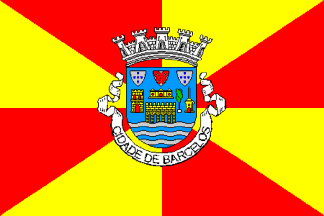
Last modified: 2015-09-05 by klaus-michael schneider
Keywords: barcelos | coat of arms | inescutcheon (saltire) | inescutcheon: portugal ancien | waves: 5 | aqueduct | river cávado |
Links: FOTW homepage |
search |
disclaimer and copyright |
write us |
mirrors

The flag is typical: a gyronny of red over yellow, with coat of arms at the centre composed of a 5-towered mural crown, a scroll reading "CIDADE DE BARCELOS" and a shield with almost as many charges as the number of communes!
Jorge Candeias, 13 Oct 1998
![[Barcelos municipality CoA]](../images/p/pt-bcl).gif) image by Sérgio Horta,
image by Sérgio Horta,
The coat of arms is blue and then it has in chef three pointy inescutcheons, the central one silver with a hollow red saltire, and the other ones silver with the portuguese quinas. In base 5 silver and blue wavystripes and along the middle we can find a yellow tower with red door and windows,
a strange ground-level building also yellow with red door and windows, a yellow wall and either a bridge or an aqueduct superimposed on the wall, plus a stylized tree and yet another yellow building with red door and window: this is probably a chapel, though the pinnacle is rather strange.
Meaning:
The only charge that makes immediate sense are the wavy lines, that stand for the river Cávado that crosses the municipality from east to west and passes by the municipal head, and also perhaps the bridge or aqueduct, I don’t know.
Jorge Candeias, 13 Oct 1998

Gyronny of red and yellow.
Jorge Candeias, 21 Jul 1999
Barcelos is a city in Northern Portugal, in the district of Braga, old province of Minho, and possible future region of Entre Douro e Minho. The municipality is not very large, 378.7 km², but relatively well populated,
116 200 inhabitants, and breaks all records concerning the number of communes: since 2013 only 61, before 89! The economy is based on industry, particularly clothes and shoes, and also agriculture. This place is also quite known abroad by it’s unique form of handicraft, the Barcelos cock (as in rooster… don’t confuse this with the
handicraft from Caldas da Rainha…)
Jorge Candeias, 13 Oct 1998
back to Municipalities of Portugal click here